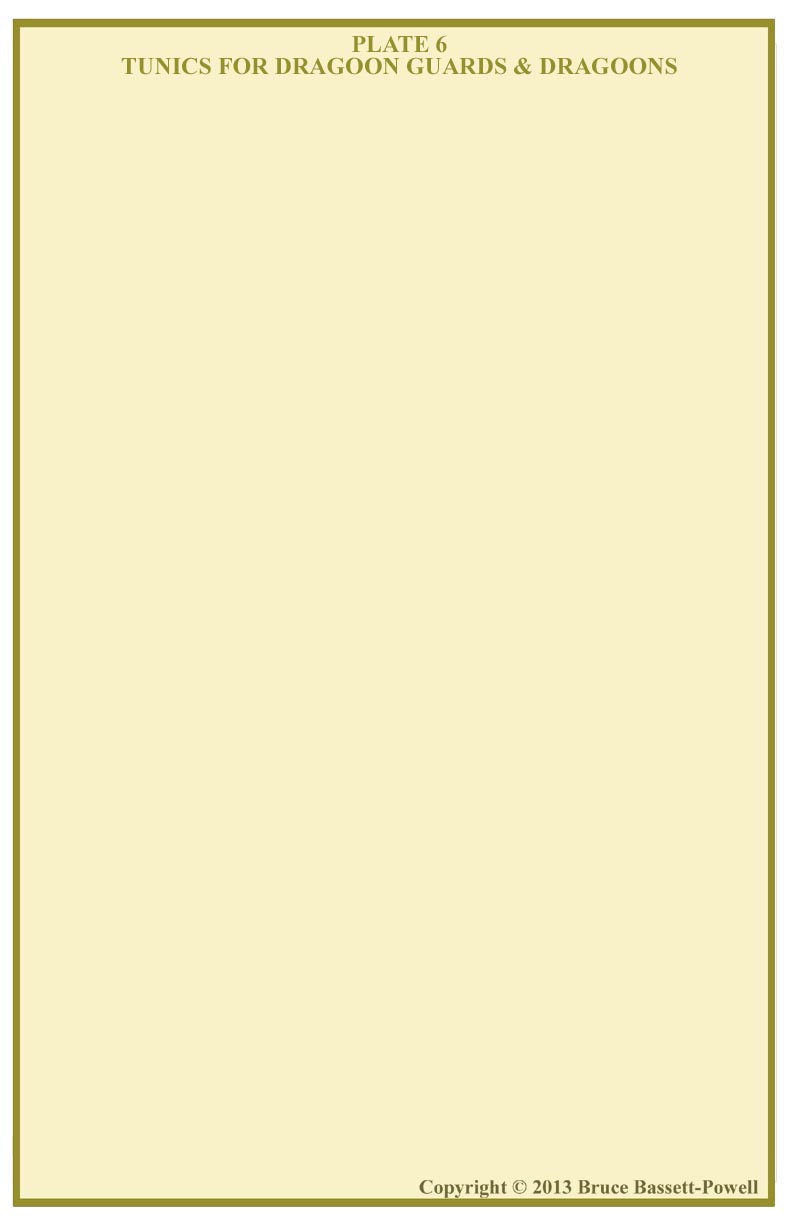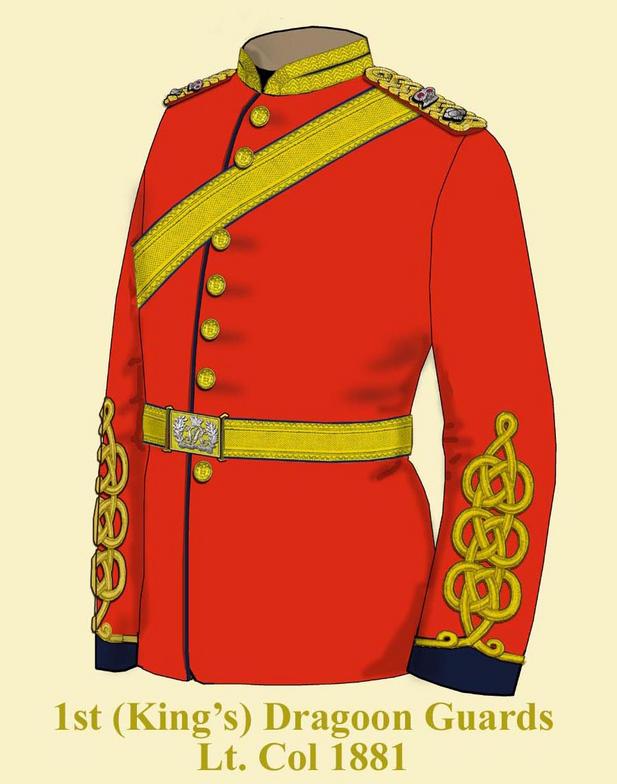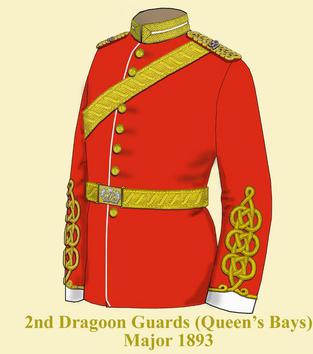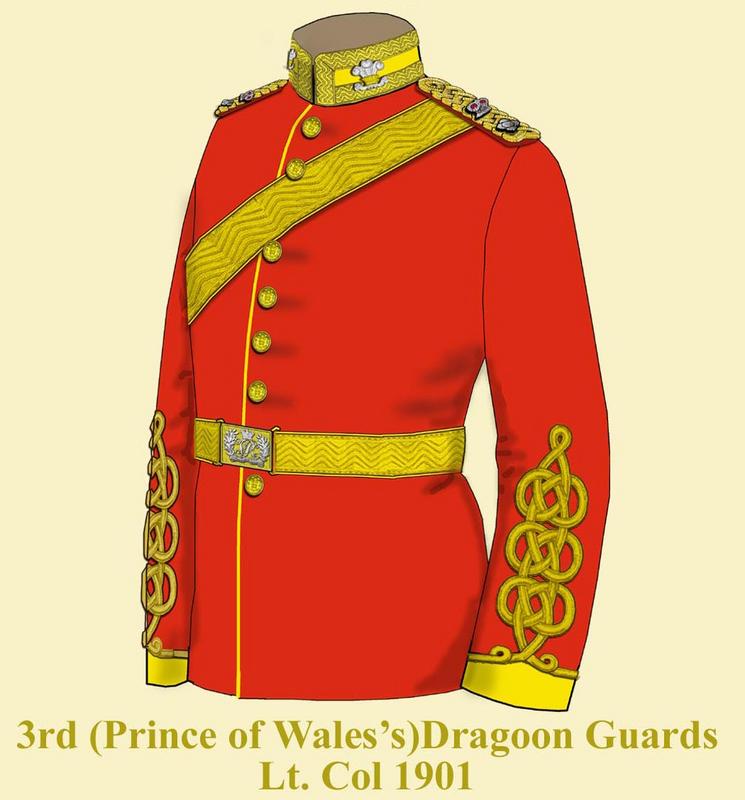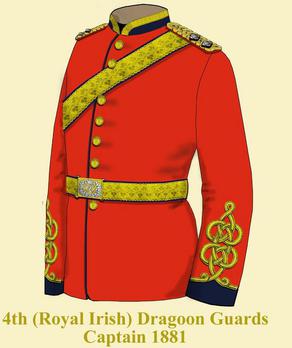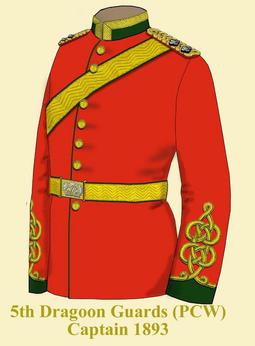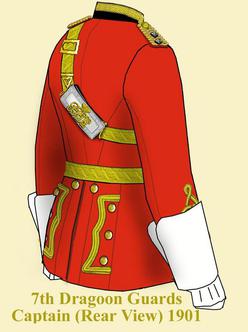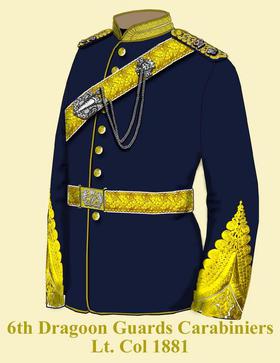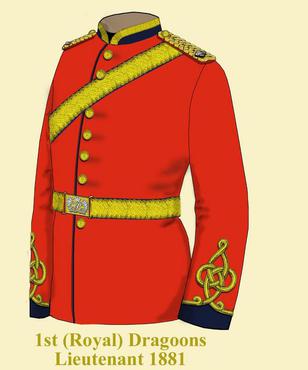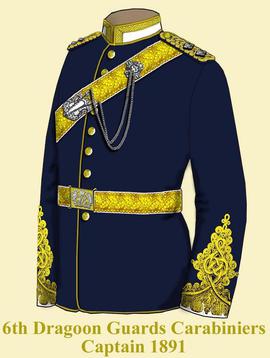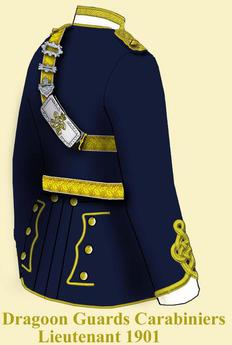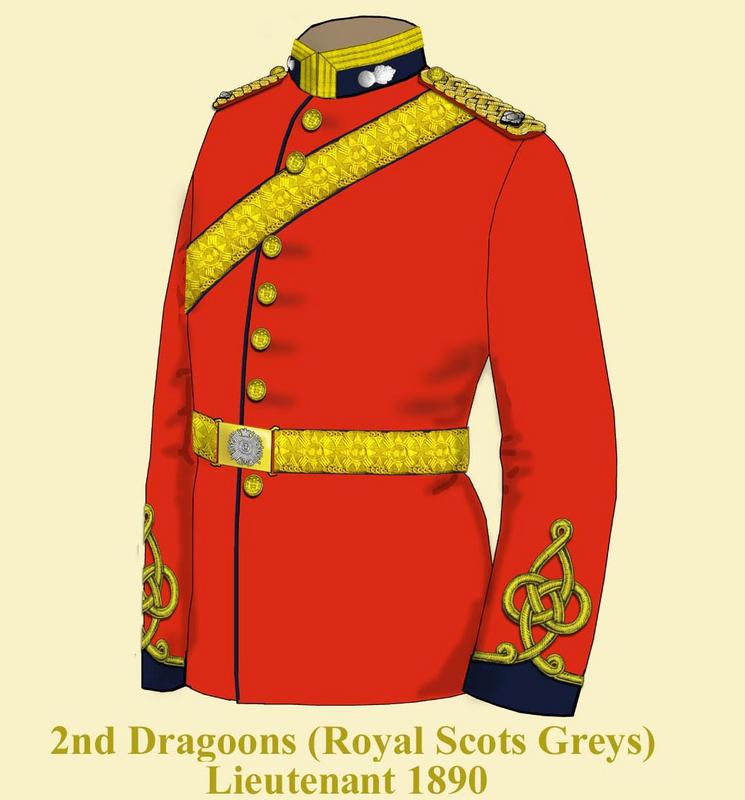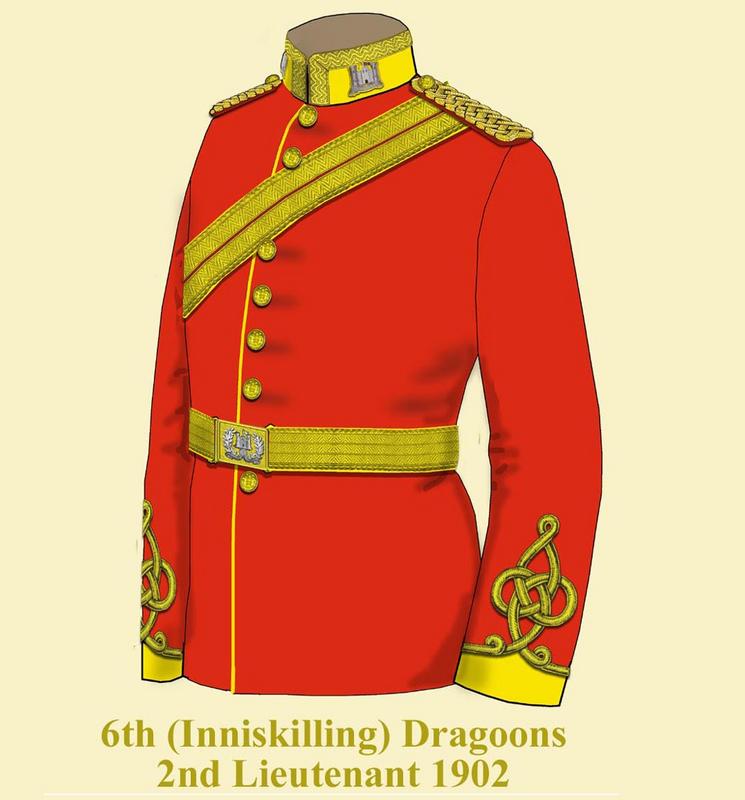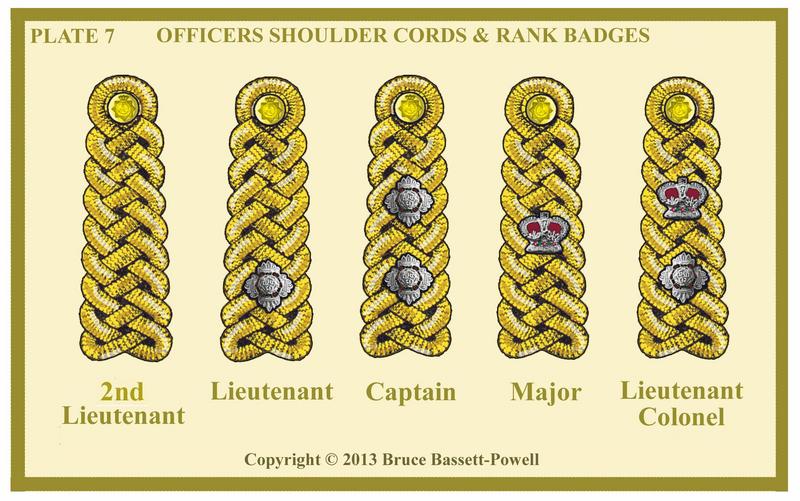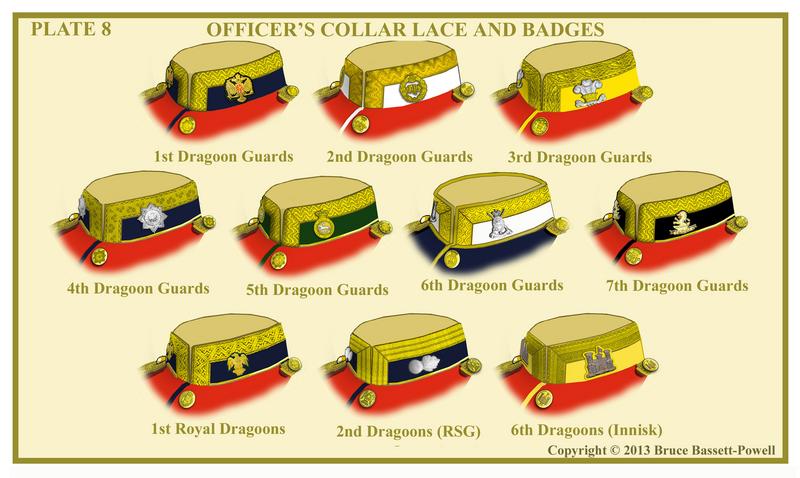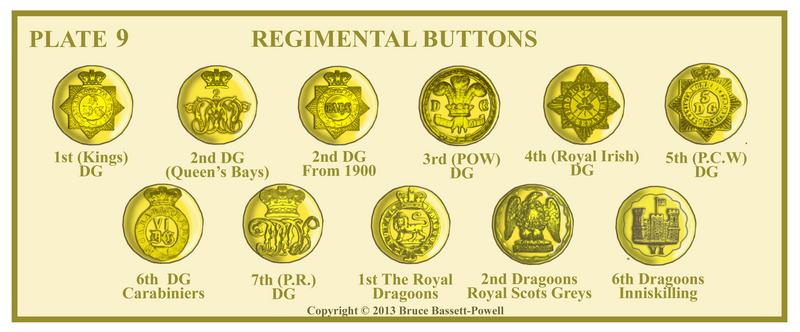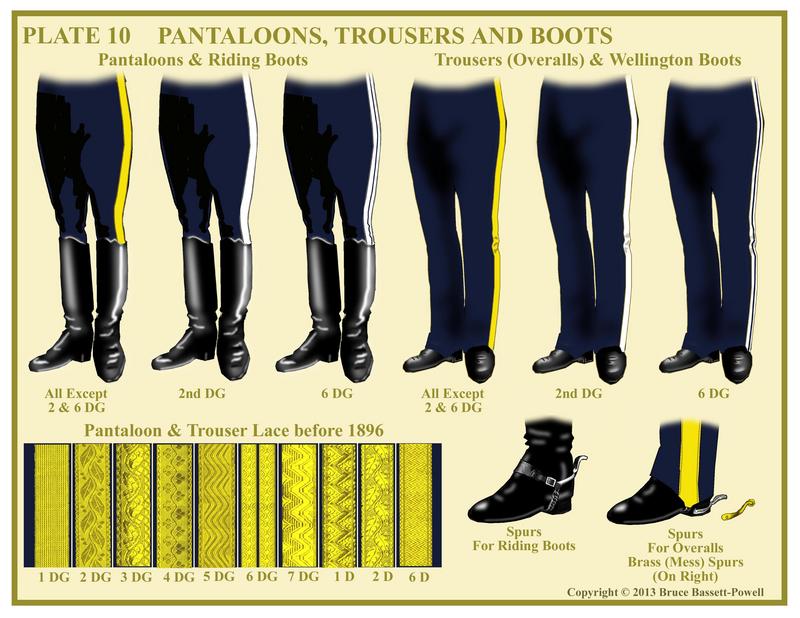HEAVY CAVALRY UNIFORMS, ARMS & EQUIPMENT - DRAGOON GUARDS & DRAGOONS
For the 6th Dragoon Guards, the tunic was of blue cloth with white facings, in memory of their brief and unconsummated conversion to light dragoons in 1853. It was the same cut as the other regiments except the front skirts were slightly rounded at the bottom. It was edged all round, including top and bottom of the collar, down the front and around the bottom of the skirts with thin round back gold cord. The cuffs were decorated with an Austrian knot which, for field officers was edged with a double row of ‘eyed’ gold braiding above and below the knot reaching to 11 ½ ins from the bottom of the cuff. Captains had the same knot with a single row of similar braiding reaching to 8 ½ ins and for lieutenants the knot was edged with plain braid. The skirt flaps were edged with the same braid as used in edging the tunic. The rank lace on the collar was the same as for the other regiments within the braiding as were the shoulder cords.
COLLAR BADGES
Until the eighteen-nineties, the only heavy cavalry regiment to wear a collar badge in full dress was the Royal Scots Greys. This had been worn since the mid 1830s which at first was a large bullion badge in gold that was also worn on the undress blue frock. After the Crimean War, when rank badges were moved to the collar the badge became silver bullion and was made smaller and angled upwards on the forward edge of the collar in front of the rank badges. After 1881, the badge became somewhat larger again. It seems to have escaped mention in any of the dress regulations until 1900 and one assumes it was classified as part of “Regimental Pattern Lace”. The first regiments to adopt collar badges were those with already well-established insignia and thus photographs showing officers of the 3rd Dragoon Guards wearing them appear in the late 1890s. Other regiments were granted privileges to wear special collar badges, one of which was the 1st Dragoon Guards. In 1896 the Austrian Emperor, Franz Joseph became Colonel-in-Chief of the regiment and in his honour it was given permission to wear the double-headed eagle as a collar badge. In 1896 the commanding officer of the 7th Dragoon Guards petitioned the War Office to allow the arms and motto of Earl of Ligonier to be used as the badge of the regiment. This was granted in 1898 and quickly adopted. By 1900, the full dress officers’collar badges of the regiments according to the dress regulations were as follows:-
1st Dragoon Guards 
 Austrian double-headed eagle in gold & Coloured bullion
Austrian double-headed eagle in gold & Coloured bullion
2nd Dragoon Guards 
 BAYS within a wreath surmounted by a crown in gilt
BAYS within a wreath surmounted by a crown in gilt
3rd Dragoon Guards 
 Silver Prince of Wales’s feathers with gilt crown
Silver Prince of Wales’s feathers with gilt crown
4th Dragoon Guards 
 Silver Star of St. Patrick
Silver Star of St. Patrick
5th Dragoon Guards 
 Gilt crown above garter. Silver V above horse, motto.*
Gilt crown above garter. Silver V above horse, motto.*
6th Dragoon Guards 
 Silver crown above garter. Crossed Carbines behind
Silver crown above garter. Crossed Carbines behind
7th Dragoon Guards 
 Arms & motto of Earl of Ligonier in gold bullion.*
Arms & motto of Earl of Ligonier in gold bullion.*
1st Dragoons 

 Eagle over “105” in gold bullion*
Eagle over “105” in gold bullion*
2nd Dragoons

 Silver bullion Grenade
Silver bullion Grenade
6th Dragoons 

 Silver bullion Castle of Inniskilling*
Silver bullion Castle of Inniskilling*
(See Plate 8)
* Collar badges of these regiments had a left & right version. In general, animals (birds, horses, gryfons etc) heads faced
Collar badges of these regiments had a left & right version. In general, animals (birds, horses, gryfons etc) heads faced
forwards and flags fluttered to the rear.
The descriptions in the regulations from 1883 to 1900 are almost identical except that the 1900 version indicates that the cuffs were 2 inches deep at the point and 1 1/2 ins at the back. They were decorated with round back gold cord lace forming a triple Austrian knot for Field Officers reaching to 11 ¾ ins from the bottom of the cuff. For Captains a double knot 9 3/4 ins high and for lieutenants it was a single knot at 7 ¾ ins high. There was a small curl in the knot above the top edge of the cuff at the midway point front and back. The collar depth from the general regulations in 1881 said the collar should not exceed 2 inches in height but that it should be rounded in front. Surviving examples and photographic evidence shows that in 1881 collars were rounded in front and about 1 3/4 ins high. It was edged in ¾ inch regimental lace, around the front, top and bottom for field officers and on the front and top for captains and below. By 1890 collars had become squared in front and about 2 ins high and at the end of the century more than 2 1/2 ins partly to accommodate the collar badges then being worn but also in imitation of the prevailing Prussian fashion. The tunic was piped down the front in the same material and colour as the cuffs and was fastened with eight regimental buttons. There were two at the rear waist and three on the points of a scalloped scarlet flap on each side of the skirt. The flaps were edged with round back gold cord lace. The depth of the tunic skirts from the general regulations were to be 9 inches for an officer 5ft 9ins in height with a ¼ inch plus or minus for every inch variation in height. In reality, they were tailored to hang straight when the officer was mounted. Plaited gold shoulder cords were worn secured by a small button at the top. (See Plate 7)
FULL DRESS TUNICS
The tunic was of scarlet cloth for all regiments except the 6th Dragoon Guards, whose uniforms were significantly different and described below. The collar and pointed cuffs were the colour of the regimental facings and material as shown in the table.
1st (King's) Dragoon Guards
2nd Dragoon Guards (The Queen's Bays)
3rd (Prince of Wales's) Dragoon Guards
4th (Royal Irish) Dragoon Guards
5th (Princess Charlotte of Wales's) Dragoon Guards
6th Dragoon Guards (Carabiniers)
7th (Princess Royal's) Dragoon Guards
1st Royal Dragoons
2nd Dragoons (Royal Scots Greys)
6th (Inniskilling) Dragoons
BUTTONS
The pattern of button worn by most heavy cavalry regiments between 1881 and 1902 were basically unchanged since the tunic was introduced in 1855. The design was the same for officers and other ranks except that the officers’ pattern was of gilt. The large buttons down the front were commonly 1” in diameter while the small ones worn on the shoulder straps were ¾”. Those worn on sleeves in undress, mess dress and the field service cap introduced in 1895 were just over ½ “ (0.6” to be precise). In 1871 other ranks of infantry regiments were ordered to wear a universal button with the Royal arms which did not affect the heavy cavalry (or most other regiments & corps). The design on the buttons for all the heavy cavalry were as worn from 1855 except the 2nd Dragoon Guards whose button introduced in 1881 were superseded by another in 1900 (but perhaps not worn till 1902). The 6th Dragoon Guards pattern dates from 1871.
(See Plate 9)
PANTALOONS, TROUSERS & FOOTWEAR
In mounted review order, officers wore pantaloons of blue cloth for all regiments. These were flared in the thigh and tight below the knee. 1n 1881 a 1¾ inch stripe of gold regimental lace was worn down each side. For the 6th Dragoon Guards, a double ¾ inch stripe, with a ¼ inch space between was worn. In 1893 gold lace stripes were abolished for all regiments and yellow lace (like the other ranks) was ordered to be worn on mounted duties. In the 2nd and 6th Dragoon Guards the stripes were white. These pantaloons tucked into black leather knee boots with a “V” cut in front. Crane neck steel spurs with straps & buckles were worn.
In dismounted review order, trousers were worn with the same gold lace down the sides as on the pantaloons. By 1893 the gold laced trousers were reserved for levées and special occasions only. Trousers with yellow stripes were worn in review order from then on. Trousers were worn with Wellington boots and boxed spurs. (See Plate 10)
GLOVES
White leather gauntlets were worn in both mounted and dismounted review order.
(See 7th Dragoon Guards in Plate 6)
Blue Velvet
White Cloth
Yellow Velvet
Blue Velvet
Dark Green Velvet
White Cloth
Black Velvet
Blue Cloth
Blue Cloth
Primrose Yellow Cloth




















